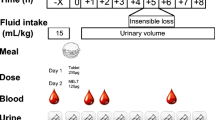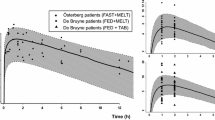Abstract
Objective
To investigate (1) the pharmacokinetic and pharmacodynamic profiles of desmopressin in men from an age group with a high incidence of nocturia; and (2) circadian variation in the pharmacokinetic parameters.
Methods
The study had an open, randomised, four-way cross-over design. Desmopressin was administered orally (0.2 mg) and intravenously (2 µg), daytime and night-time, yielding four in-hospital sessions, separated by at least 2 days. Blood samples were taken before and at predetermined time points up to 12 h after dosing. Pharmacokinetic parameters were derived using a two-compartmental model except for AUC(0→t), which was derived using non-compartmental analysis. Bioavailability was estimated using AUC(0→t) for the oral and the intravenous periods. Urine, for measurements of volume and osmolality, was collected in predetermined intervals before and until 12 h after dosing.
Results
Fifteen healthy men aged 55–70 years were included in the analysis. The concentration–time curve after 2 µg intravenous desmopressin was best described using a biexponential term. The mean (95% CI) AUC at night was 302 (272–335) pg×h/ml and in the day was 281 (253–312) pg×h/ml. No statistically significant differences were detected between night and day except for terminal half-life, which was 3.1 h at night and 2.8 h in the daytime (P=0.02). After oral desmopressin, concentrations above the limit of quantification (2.5 pg/ml) were only detected in 51% of the samples. Peak plasma concentration (Cmax) was 6.2 (5.1–7.5) pg/ml at night and 6.6 (5.5–7.9) pg/ml in the daytime. Median time to reach Cmax (tmax) was 1.5 (range 1.0–4.1) h at night and 1.5 (range 0.5–3.0) h in the day. The bioavailability was 0.08%. The pharmacodynamic effects of oral and intravenous desmopressin given in the daytime were similar during the first 6 h after dosing. The night-time dosing and daytime intravenous dose resulted in antidiuresis throughout the measuring period, while the effect of the daytime peroral dose receded after 6 h.
Conclusion
The pharmacokinetic profile of desmopressin is biexponential. Terminal half-life was longer at night than in the daytime, but the difference is considered too small to be of clinical importance. The plasma levels given by the intravenous dose resulted in a duration of action of 12 h or more. Despite low bioavailability, the pharmacodynamic effects of oral desmopressin were similar in magnitude to those after intravenous dose at night and during the first 6 h after daytime administration.



Similar content being viewed by others
References
Mattiasson A, Abrams P, van Kerrebroeck P, Walter S, Weiss J (2002) Efficacy of desmopressin in the treatment of nocturia: a double-blind placebo-controlled study in men. BJU Int 89:855–862
Cannon A, Carter P, McConnell A, Abrams P (1999) Desmopressin in the treatment of nocturnal polyuria in the male. BJU Int 84:20–24
Carter P, McConnell A, Abrams P (1992) The safety and efficacy of DDAVP in the elderly. Neurourol Urodynam 11:421–422
Asplund R, Sundberg B, Bengtsson P (1999) Oral desmopressin for nocturnal polyuria in elderly subjects: a double-blind, placebo-controlled randomized exploratory study. BJU Int 83:591–595
Britton J, Dowell A, Whelan P (1990) Prevalence of urinary symptoms in men aged over 60. Br J Urol 66:175–176
Blanker M, Bohnen A, Groeneveld F, Bernsen R, Prins A, Bosch J (2000) Normal voiding patterns and determinants of increased diurnal and nocturnal voiding frequency in elderly men. J Urol 164:1201–1205
Kageyama T, Kabuto M, Nitta H, Kurokawa Y, Taira K, Suzuki S, Takemoto T-I (2000) Prevalence of nocturia among Japanese adults. Psychiatry Clin Neurosci 54:299–300
Argenti D, Jensen BK, Heald D (1997) The pharmacokinetics and pharmacodynamics of desmopressin: effect on plasma factor VIII:C and von Willebrand factor. Am J Ther 4:3–8
Callréus T, Höglund P (1998) Pharmacokinetics and antidiuretic effect of intravenous administration of desmopressin in orally overhydrated male volunteers. Pharmacol Toxicol 83:259–262
Eller N, Kollenz C, Hitzenberger G (1998) A comparative study of pharmacodynamics and bioavailability of two different desmopressin nasal sprays. Int J Clin Pharmacol Ther 36:139–145
Fjellestad-Paulsen A, Höglund P, Lundin S, Paulsen O (1993) Pharmacokinetics of 1-deamino-8-D-arginine vasopressin after various routes of administration in healthy volunteers. Clin Endocrinol 38:177–182
Köhler M, Harris A (1988) Pharmacokinetics and haematological effects of desmopressin. Eur J Clin Pharmacol 35:281–285
Rittig S, Jensen AR, Jensen KT, Pedersen EB (1998) Effect of food intake on the pharmacokinetics and antidiuretic activity of oral desmopressin (dDAVP) in hydrated normal subjects. Clin Endocrinol 48:235–241
Vilhardt H, Lundin S, Falch J (1986) Plasma kinetics of DDAVP in man. Acta Pharmacol Toxicol 58:379–381
Vilhardt H, Lundin S (1986) Biological effect and plasma concentrations of dDAVP after intranasal and peroral administration to humans. Gen Pharmacol 17:481–483
Lam K, Wat M, Choi K, Ip T, Pang R, Kumana C (1996) Pharmacokinetics, pharmacodynamics, long-term efficacy and safety of oral 1-deamino-8-D-arginine vasopressin in adult patients with central diabetes insipidus. Br J Pharmacol 42:379–385
Nevéus T, Läckgren G, Tuvemo T, Stenberg A (1999) Osmoregulation and desmopressin pharmacokinetics in enuretic children. Pediatrics 103:65–70
Jackson S (1999) Lower urinary tract symptoms and nocturia in men and women: prevalence, aetiology and diagnosis. BJU Int 84[Suppl 1]:5–8
Asplund R, Sundberg B, Bengtsson P (1998) Desmopressin for treatment of nocturnal polyuria in the elderly: a dose-titration study. Br J Urol 82:642–646
Acknowledgements
We thank the study nurse Susanne Henriksen, Jonas Lundahl and Nedjad Losic for pharmacokinetic and statistical analyses, and Ferring AB for financial support. The study was performed in accordance with Danish law. This study was performed at the Department of Clinical Experimental Research, Skejby University Hospital, Aarhus, Denmark.
Author information
Authors and Affiliations
Corresponding author
Rights and permissions
About this article
Cite this article
Rembratt, A., Graugaard-Jensen, C., Senderovitz, T. et al. Pharmacokinetics and pharmacodynamics of desmopressin administered orally versus intravenously at daytime versus night-time in healthy men aged 55–70 years. Eur J Clin Pharmacol 60, 397–402 (2004). https://doi.org/10.1007/s00228-004-0781-9
Received:
Accepted:
Published:
Issue Date:
DOI: https://doi.org/10.1007/s00228-004-0781-9




